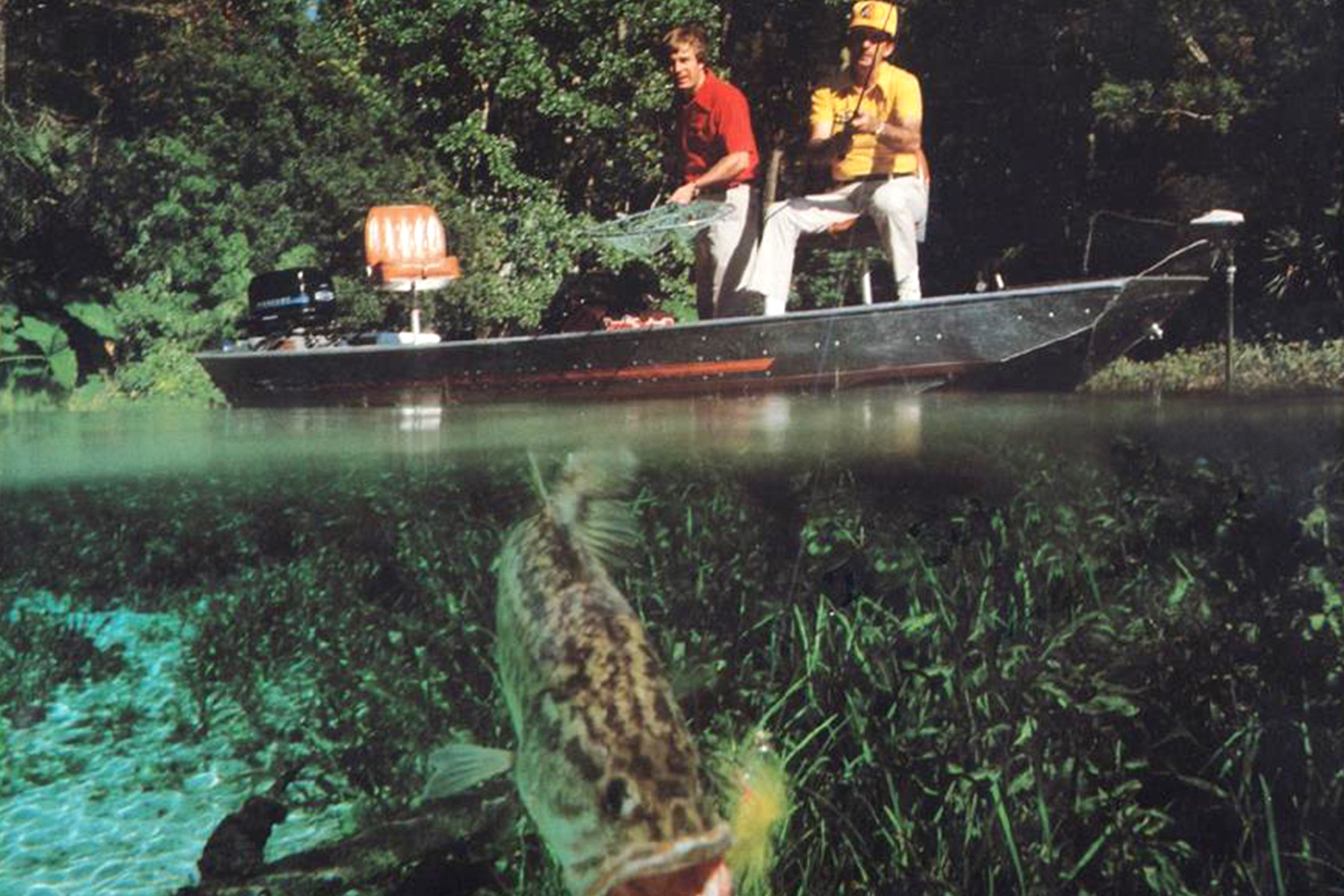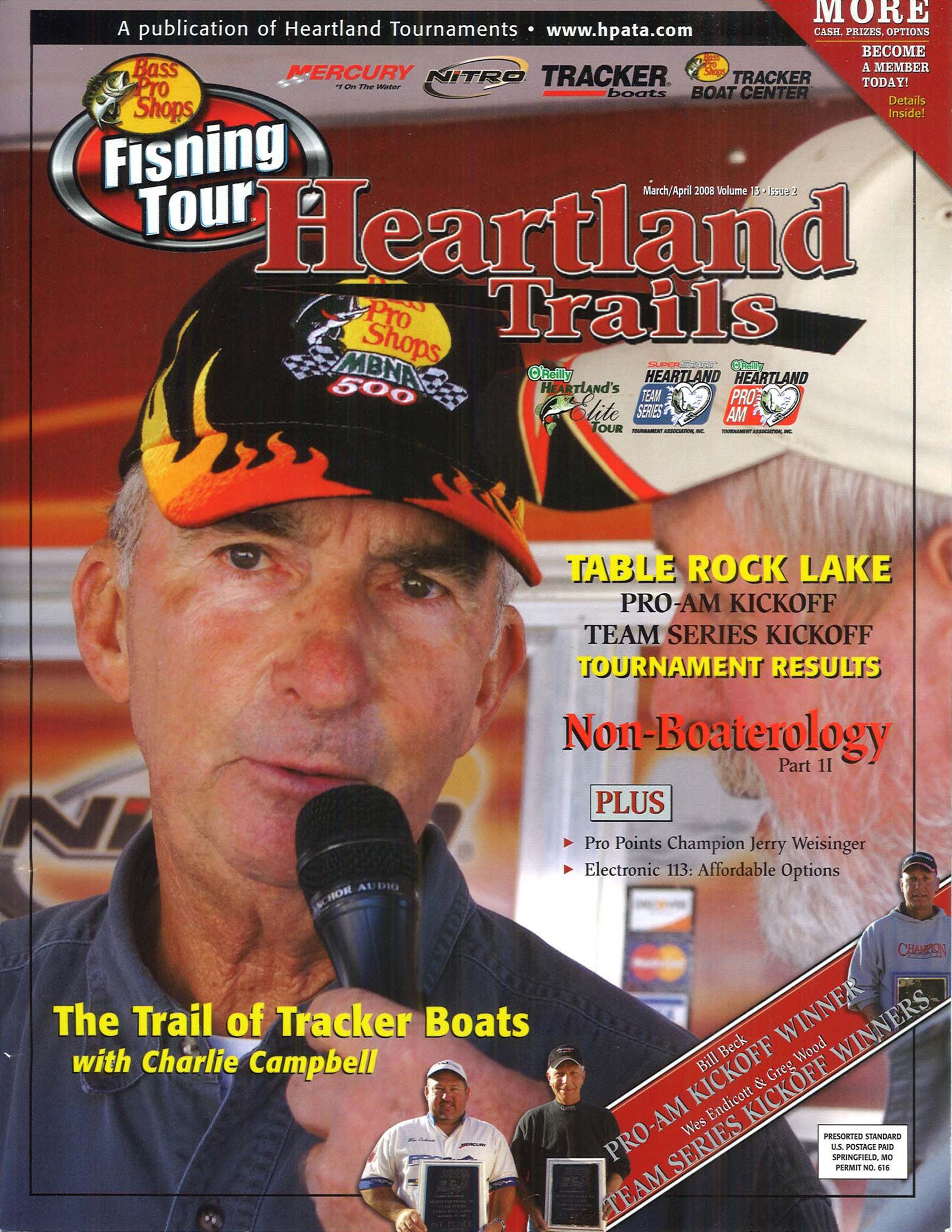"You're going to be surprised how it all started. A long time ago when l was fishing tournaments, back then there were guys fishing BASS and they also had a tournament for the bass club guys. The clubs had state tournaments and then there was a national tournament, I had won the Chapter Championship tournament (1974) and then I went back again to finish 4th (1976). At the same time I was 6th or 7th in the BASS standings and finished 5th in the Bassmasters Classic (1974). Around that time Ray Scott devised a tournament called the BASS Champs Tournament. We all met down in Tennessee just out of Nashville (Percy Priest Reservoir). This was in 1977. Ray had a 15-foot aluminum boat he had made a bass boat out of. It was just a little, regular flat bottom boat with a steering wheel, a trolling motor up front and an aerated livewell in it. A 35 horsepower Johnson motor was on the back, one battery, one gas tank and that was all we could use.
We all met outside of Nashville, Ray took us to this lake and we drew partners to go out fishing. To save my battery on the 35 horse motor I pulled the cover off of it and used the rope to hand start it since there was only one battery. This allowed us to fish all day long. We fished on one battery, five gallons of gasoline with a 12 volt trolling motor and an aerated livewell. I caught my limit of bass and I think I took 4th in the tournament.
I was so thrilled about how well that little boat worked because in a tournament back then, a 135 horse motor on a Ranger boat was a big boat. We all had them and were able to run all over the lake but it was so nice to have a little boat, you couldn't go very far but everyone caught a lot of fish and had a good time.
So when I got back home to my marine shop in Branson, I got to thinking about that little aluminum boat and how to make it better. I drew out plans for a 16 foot aluminum boat and took it to Lowe and Applebee boat companies in Lebanon. I bought boats from them for my marine shop. I showed them the plans for this boat and wanted them to build it so I could sell it at my shop in Branson. And they kindly laughed at me and said they couldn't build a bass boat out of an aluminum flat bottom. So I forgot about it.
Shortly after that, I was on my way to the Bassmaster Classic again. We all flew down to Atlanta, Georgia to meet with Ray Scott to get on another plane. We got on with our wives and flew to a "secret lake" (Lake Toho, Florida). Johnny Morris was also on the plane. I had fished with Johnny quite a bit back home and even rigged a Ranger boat for him at my marine shop. He was sitting in the seat in front of me and he turned around to talk to me about how that tournament went (BASS Champs Tournament). I told him about how nice that little aluminum boat was and I had drawn up some plans to have one built. Johnny had asked me all about the boat but I didn’t think much of it at the time.
About two weeks after the Classic, Johnny called me up and said "Come up here to Springfield, I want to talk to you." I said ok, I thought we were going fishing or something like we usually did. So l head up there and Johnny said "You know that boat you were telling me about? How would you like to come up here, help me put the boat together and sell it in the catalog?” I laughed at him and said "you can't sell a boat out of a catalog!” “Johnny replied, "Well, I think I can.”
So finally Johnny told me he would pay my way to fish all the tournaments, furnish a car and I would represent Bass Pro Shops as he was going to stop fishing tournaments. I told Johnny that l would have to go home and talk to my wife. So I talked to her and she wasn't too hip on it either! See, Johnny was still pretty young and just out of college but he finally talked me into do it.
I went up to Springfield and we sat down with my plans. We used one gas tank, one battery, a trolling motor on the bow; a depth finder and people could buy an extra battery if they wanted it. We designed a bass boat that was just perfect and called it a Bass Tracker. The name came about from Johnny; he always came up with the names. He also had the logo made up with the bass in the cross-hairs in the center of Bass Tracker.
I took the plans and went to the major aluminum boat companies. I went to Lowe, Applebee, Arkansas Traveler and Delhi Boat Company in Louisiana to have them build us a prototype. We paid them to build the prototype and told them if we chose theirs, we would like them to build this boat.
Out of all the boats, the Delhi boat was by far the best and we picked it. We ordered fifty boats and from my marine shop we also ordered fifty 35 horse Johnson motors. The boats and motors were trucked in and we took everything out to Johnny Morris' warehouse in Springfield where his dad stored all the liquor for the Brown Derby stores. I put together a crew of guys to start building these boats. We only had one boat called the Bass Tracker.
It was easy to build since they were all the same. It didn't take long to put the boats together and when the first one was done, I took it down to Florida to have pictures taken by Glen Lau. Glen Lau won many awards for the film Bigmouth and took great underwater pictures of bass. We had him take pictures of the boat in the water; l was in the boat and made this eleven pound bass jump next to the boat while Glen waded in the water to take photographs. The pictures were beautiful and we put them in the catalog (1978).
The catalog came out with a total package price of $2995 and by the time everyone got the catalog, we sold all the boats. It hit just right because this was the time of the big gas crunch and a lot of the big boat companies went under. This little Tracker sold like hot cakes and we were selling them as fast as we could make them.
When all the Johnson outboard motor dealers saw how much we were selling them for, they raise holy cane and wouldn't sell me anymore motors at the marine shop. So we couldn’t get any more motors for the boats. At the same time, Mercury motors were having trouble and ready to go under. They were in Chapter 11 and about bankrupt. We went to them and asked if they would sell us a 40 horsepower motor to put on the Tracker boat. They agreed and we made a deal to have Mercury motors on the boats.
We didn't have dealers, just sold the boats over the telephone and people would come to Springfield to pick them up. They came from all over the county; people even came from California to get one. They came from everywhere. We had all kinds of trouble with the trailers, the guy we had building them would come with wet paint on the trailer. Also, people would pick up a boat to only get ten miles out of town before the ball bearings would burn out. So finally we had to build our own trailers in another warehouse that Johnny 's dad owned.
Eventually, Delhi Boat Company couldn't build us enough boats so we started our own boat factory (1982). Some customers wanted a little smaller boat, which we called a Bass Tracker I and some wanted a little bigger boat, which was the Bass Tracker III.
We also went on to begin making pontoon boats (1983) and started the same way, we bought every good pontoon boat in the county and fixed ours up so it would be a little better. Johnny and I designed it and came up with the buggy or bimini top. The guys at the aluminum plant figured out a way to roll a round log (pontoon). Most of the companies had aluminum logs that were flat on top and they had a lot of trouble with that. We had a stronger round log on a good pontoon boat. These also sold as fast as we could build them.
We had four boats and then decided to get into the fiberglass market. I drew up the first plans for our fiberglass boat and I took it down to Earl Bentz. Earl had been my rep for HydroSport in my shop in Branson. I was the top HydroSport dealer for three or four years while I was in Branson. He was supposed to be taking over HydroSport but the owner sold it out from under him. Earl didn't get the business so he started Stratos boats and wanted me to be partners with him. I told him no because Johnny had been so good to me. Earl took my plans and built our first 17' 10" fiberglass boat (1985).
Our fiberglass boats took off and it was a handful also. Tommy Martin and I were good friends from staying together on the tournament circuit. He found a boat company in Texas that was having a hard time and about to lose it. Tommy talked to me and the owner was interested in selling. We got him and Johnny together and we bought Nitro Boat Company with the help of Tommy (1988), So that's how we started with Nitro boats.
I was there for about 15 years and then my health started to go down. I had been working what seemed like 15 to 18 hours a day doing everything that needed to be done plus fishing tournaments. My doctor told me I had to get out of there or I wouldn't make it another two years. So I talked to Johnny but he said "oh no, just stay one more year. Just one more." So I did and then finally retired. I still helped out as I could and we started up the dealer network. When I left up there, we only had three or four aluminum boats, two fiberglass boats and had just started expanding the pontoon boat line. I look at the boats today and see all the different lines and models but just can't believe where it all came from."
Where it all came from was a simple beginning and the ideas of two men. Those ideas were believed in when others laughed and now Tracker boats and Sun Tracker pontoons are the #1 selling aluminum boat lines in the world. Although he would humbly deflect any praise or recognition, Charlie unknowingly was the genesis of a series of events that made an indelible mark on the angling world. Innovation and affordability has kept Tracker in the lead for 30 years and pioneers like Charlie Campbell and Johnny Morris will always be remembered as the true leaders of a revolution.


